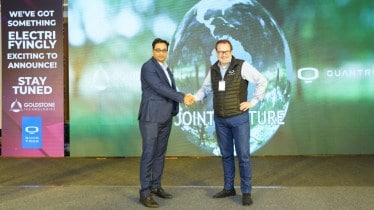The relationship between India and Germany has been traditionally strong for decades, and the growing focus by German companies when it comes to investing and establishing partnerships in India comes as no surprise.
For electric commercial vehicle manufacturer Quantron, the JV with Hyderabad-headquartered Goldstone Technologies is not about launching EVs in India, but supporting an ecosystem towards zero-emission vehicles. They plan to invest up to “double-digit million euros or around Rs 80-100 crore by 2025”.
Speaking to Financial Express Online, Michael Perschke, Member of the Board & CEO, Quantron said that the investment will not just be from the JV partners, but also may come from future partners which could be OEMs, utility companies or energy companies.
“It will be an exclusive JVs between us, but we are open to other investors and partners over time. We want to cover the entire value chain and that’s why will be open to investors over the years.”
This he hints could be energy companies, OEMs, insurance companies, or even fleet operators. The idea is to “create a consortium of companies and not a purely exclusive play.”
Goldstone Technologies, which is the brain behind the creation of the platform, will focus on five distinct pillars – Fleet Management, Insurance-as-a-Service, Hydrogen Economy, Greenhouse Gas Accounting, and Data Insights. Depending on the requirements of the customers they could opt for a single modular solution or take the entire gamut of offerings.
Quantron has no plans to enter CV manufacturing in India
Responding to a query if Quantron would bring its electric or hydrogen CVs to India, Perschke says, “I don’t have the ambition to become an OEM brand in India. Looking at the experience of Volkswagen which in 16 years has not been able to be profitable or how long it took BharatBenz to get a stable business model. We are looking more at Quantron Inside effect if there is any company that aims to build buses and trucks and wants to fast-track experience with hydrogen fuel cell integration. We will come onboard as an integrator of technology and components where we have value addition.”
He further states that the company has received a “bit of interest from not only vehicle manufacturers but heavy electrical companies for marine and train applications.”
Global plans
For the near future, the focus for Quantron would remain on Europe, USA, the Middle East, and then India.
The JV will also look beyond just India, while the partners have already announced the setting up of operations in Germany and Hyderabad. Quantron will focus on Europe, parts of the Middle East, and the USA, Goldstone on the other hand will look at clients in India and the eastern part of Asia.
When queried about plans to rope in a third partner to manufacture vehicles in India, Pavan Chavali, MD, Goldstone Technologies says that the JV has been in the works for the last 12-18 months. “ETO Motors and Quantron are the first customers for the JV. Any organisation which offers Mobility-as-a-Service would be a partner or customer in the future for us.”
Perschke adds, “We are open to anybody who is committed to the ultimate mission of decarbonisation of people and goods. And if tomorrow say Foxconn wants to produce Quantron vehicles, we will provide the platform and the JV will bring in the enablers. We are building something which is OEM agnostic, and not building for one company over the other.”
Green vehicle penetration to reach upto 30-40% by 2030
One of the most ambitious targets globally for attaining a certain degree of reduction in emissions has been for the year 2030. The ambitious target has varied from achieving a small percentage to a complete transition depending on who you ask.
A key driver for higher adoption of electric vehicles globally has been the government subsidy or incentive. But again for a country like India, there have been challenges.
Chavali believes that “Environment degradation is a reality, and the situation is not going to wait for government subsidies. The incentives given is encouraging and help things move forward. It is no longer optional at this point of time, but 30-40 percent of all private and commercial vehicles have to go electric. The only question is what will be the cost of it.”
He credits the Central and State subsidies to help drive the momentum but cautions that the long-term roadmap can not just be based on subsidies.
Talking about ETO Motors, the three-wheeler sister company for Goldstone, Chavali said that it has already deployed over 1,500 EVs on the road (800 cargo and more than 600 passenger vehicles) and has an order book of 2,500 units in the coming quarter.
In fact, the partners are confident that just between the existing synergies, they will be able to support over 100,000 electric vehicles by 2030. This is without taking into account new partnerships.
